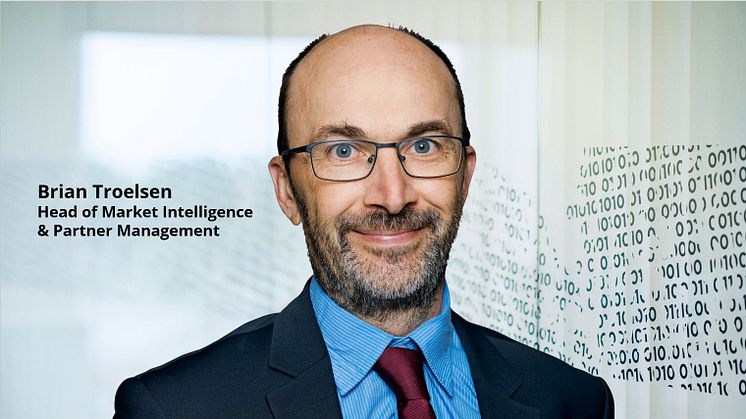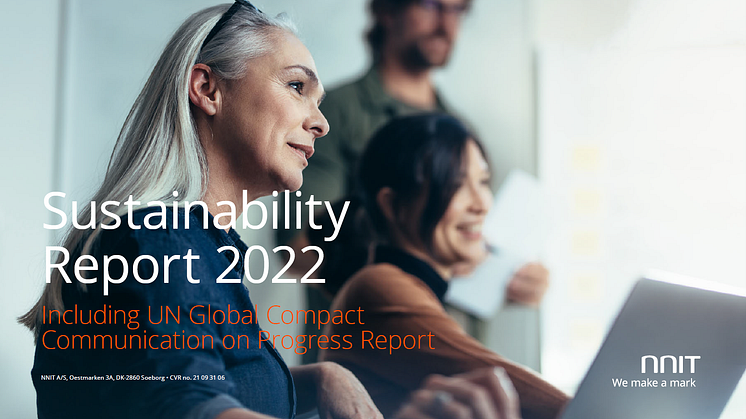
News -
Digital packaging is key to sustainable growth
According to the respondents in the NNIT Expectation Barometer 2022, a lack of competent resources is one of the primary barriers to growth. This article takes a closer look at how you can use the digital potential of your organization as a springboard for long-term sustainable growth.
In the past few years, we have seen how digitalization has moved into the core of many companies’ business, and the importance of digital sales channels are growing rapidly.
At the same time, a number of companies are in a fundamental state of uncertainty, and, according to Brian Troelsen, Head of Market Intelligence and Partner Management in NNIT, precisely digital solutions can help stabilize and predict otherwise unknown events and threats:
"If you’re equipped with a digital toolbox, you increase your rate of adaptability because you become able to analyze, predict, and, not least, react to the events that occur on an ongoing basis," he says and adds:
"Previously, many companies prepared business strategies and plans in the same way as a marathon runner who trains for a race by running at an even pace over a long distance. A plan is made for the course, and because the marathon runner knows the exact route and final destination, he knows precisely how to use his energy optimally".
Brian Troelsen finds that, as a digital manager, you should instead prepare plans like an orienteering runner, who is more geared towards navigating a state of unpredictability:
"We live in times in which both internal and external events may shake the foundation of the business overnight. Therefore, you should instead strive to prepare strategies and plans as an orienteering runner, who is highly trained in being agile, changing direction and spotting new paths. And here, digitalization plays a crucial role in supporting agile and sustainable business plans".
Rethink user experience in a digital context
Digitalization holds an increasingly important place in the products and services with which we surround ourselves. This is confirmed by the respondents in this year’s Expectation Barometer when they are asked to what extent digitalization is an integral part of their products and services.
Almost 40 percent of the respondents answer that their products or services are very digital.
"It doesn’t surprise me, and we should expect this share to increase in all industries in the coming years," says Brian Troelsen and makes an example from the automotive industry:
"An electric car is increasingly regarded as a computer that provides the driver and passengers with digital and interactive functionalities and which – if used correctly – improves the user experience. At the same time, all the continuous updates of the car take place in the cloud, thereby minimizing visits to the car repair shop".
Another example is banks and fintech services, which increasingly offer financial services in digital packaging:
"Services such as loans and advice are basic services that a bank must be able to provide as a minimum. But the digital solutions in the form of apps and other digital functions in which the services are wrapped are crucial to the customer experience and to whether customers remain with you or switch to the competitor," Brian Troelsen explains.
The respondents’ answers in the Expectation Barometer also show that the companies have great focus on the digital channels. When the respondents are asked how important their organization’s digital channels are relative to the conventional physical channels, almost one in three (29 percent) answer that digital channels are the most important, while one in five (20 percent) believe that the conventional channels are the most important.
The physical channels are thus far from being superfluous, but there is no getting around the fact that the physical purchasing experience must be rethought in a digital context if you are to realize your growth ambitions as a company:
"Even though you visit a physical shop, the purchasing experience may very well be digital, including by means of augmented reality, where, using smart glasses, the customers get a taste of what, for example, a kitchen or a speaker will look like in their own home," says Brian Troelsen.
Utilize your digital appetite
When we can see that digitalization is being woven into more and more products and services, it is crucial that, as a company, you are capable of building up a digital narrative and creating an interesting story around your brand.
A large part of the respondents in this year’s Expectation Barometer recognize this. Here, it becomes clear that just under 40 percent of the respondents rate their organization’s digital narrative to be above average, while 10 percent find that it is excellent. Only 4 percent of the respondents believe their digital narrative is very weak.
According to Brian Troelsen, a digital narrative is important for both the up-and-coming startup and the 100-year-old company:
"You should communicate not just your company’s sustainable ambitions, but also your digital objectives. Maybe you’re an entrepreneur who is revolutionizing an otherwise traditional industry with a digital product. Or perhaps you’re a longstanding company which has made a digital turnaround that combines its existing history and traditions with cutting-edge technology," he says and emphasizes:
"Utilize your digital appetite and tell the outside world how your digital ambitions are improving your services and customer experience".
Digital upskilling is the way to an agile workforce
Although the events of recent years have highlighted new and successful business models, there are still companies that struggle with various growth barriers.
In this year’s Expectation Barometer, more than half of the respondents (52 percent) stated that a lack of competent resources and talent is the biggest barrier to development and growth in the organization, while 38 percent believe that a lack of IT skills among their employees outside the IT department is the biggest obstacle. Here, Brian Troelsen has a clear recommendation:
"Don’t be afraid to hire profiles without IT experience. Instead, focus on upskilling them, so they can combine their industry knowledge and profession with new digital tools. They represent the above-mentioned orienteer runners, who can combine different competences and contribute to realizing your growth ambitions".
Another growth barrier is a lack of support from the senior management, which one fifth (20 percent) of the respondents pinpoint as the biggest obstacle to the company’s development and continued growth.
Especially respondents from the public sector score high on this answer. Brian Troelsen gives his take on what the reason for this may be:
"The public sector has certainly been slower in making their digital transformation. Many of the public systems are customized and can take a long time to get approved and implemented, and the senior management is probably not so IT savvy that they understand all the opportunities and risks connected with the various digital solutions," he says and adds:
"Having said that, the Danish public sector is light years ahead of most European countries, because our digital infrastructure has made it easy and agile to be a Dane and to keep the wheels of society turning despite turbulent circumstances. We can be proud of that".
How do you utilize digital potential to promote your sustainability?
You can still take part in the NNIT Expectation Barometer 2022. When taking the test, you will get your own score on how digitally sustainable your organization is – and the opportunity to benchmark yourself with seven digital leaders from some of Denmark’s largest companies.
How digitally sustainable is your organization? Take the test.





